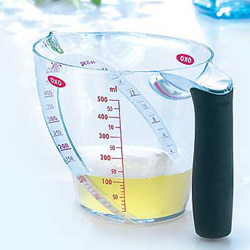
Oxo Good Grips 4 Cup Angled Measuring Jug
Priced from
£9.00
What we say
Toughened glass jugs with angled surface inside, enabling the user to read the measurements from above, eliminating the need to bend down so the numbers are at eye level. Measures in millilitres and US cups.
ADD FOR COMPARISON
Hire through Lendocare
This product is unfortunately unavailable for hire, however; you can express your interest in making this product available for hire by clicking the button below!
If you are a national retailer who is not listed please read our faqs to find out how to add your company. If you are listed and need to update your details please read how to update your listing.
Product Information
Manufacturer's Product Description
The manufacturer has not provided any further information about this product
Manufacturer's Contact Details
Oxo
USA
Key Features
No Key Features have been specified for this product
Product Dimensions
| Dimensions | |
|---|---|
| Volume | "N/A" |
| Volume | 250; 500; 1000ml |
Product Specification
No product specification has been specified.
